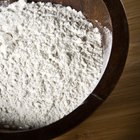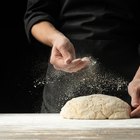
Besan flour is a staple in Indian and Bangladeshi dishes. The flour is from milling roasted chickpeas and gives food dishes a nutty flavor with a heartier texture. You can bake with besan flour, making anything you would with all-purpose flour such as cakes, cookies, pizza dough and breads. Besan flour has 387 calories per cup and is high in fiber, calcium and protein, making it a healthier alternative to all-purpose flour.
Substitute besan flour for all-purpose flour. Cakes and breads will not rise as much with besan flour and will be thicker in texture.
Sift the flour twice before adding it to any baking recipe to increase air surrounding the flour. This incorporates more air into the recipe making lighter baked goods.
Increase yeast when baking breads and cakes to help the loft. Adjust recipes with an additional 50 percent of yeast. If the recipe calls for 2 tsp. of yeast, add 3 tsp. of yeast.
Add extra baking soda to recipes that don't call for yeast to aid in rising. Increase 1 tsp. of baking soda to 1 1/2. This helps create lighter texture with the soda bubbling through cooking.
Related Articles
Cooking With Wheat Vs. White Flour

Can I Substitute Bleached for ...

How to Make Toasted Bread Sticks With ...

Can You Use Bread Flour Instead of ...
How to Make Bread That Does Not Crumble ...

How to Make Pumpernickel Flour

Can You Use Konjac Flour in Baking?

Can You Substitute Butter for ...

How to Replace Flour With Oat Flour

How to Freeze Brioche

How to Dust a Pan With Flour

Does Cornstarch Make Fried Chicken ...

Can You Refrigerate Homemade Yeast ...

How to Substitute Cornstarch for ...

Do Eggs Make Baked Goods Rise?

How to Increase the Yeast Taste in Bread

Can You Make Dumplings With Corn Starch?

How to Add Gluten to All-Purpose Flour

What Kind of Flour to Use for Cupcakes?

Does Unbleached Bread Flour Make ...
References
- "Cook Wise"; Shirley O. Corriher; William Morrow Cookboooks; 1997
- Recipe Tips: Flour Tips and Substitutions
- Food Subs: Nonwheat Flours
- Recipe Tips: Nutrition Information for Chickpea Flour
Writer Bio
With more than 15 years of professional writing experience, Kimberlee finds it fun to take technical mumbo-jumbo and make it fun! Her first career was in financial services and insurance.
Photo Credits
Jupiterimages/Goodshoot/Getty Images